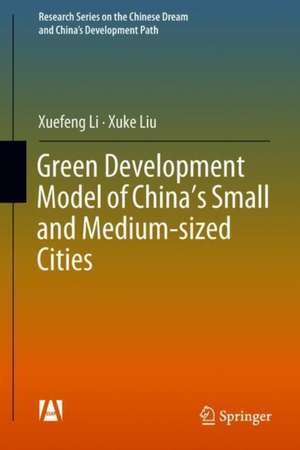Green Development Model of China’s Small and Medium-sized Cities: Research Series on the Chinese Dream and China’s Development Path
Autor Xuefeng Li, Xuke Liuen Limba Engleză Hardback – 2 aug 2018
| Toate formatele și edițiile | Preț | Express |
|---|---|---|
| Paperback (1) | 383.50 lei 6-8 săpt. | |
| Springer Nature Singapore – 19 ian 2019 | 383.50 lei 6-8 săpt. | |
| Hardback (1) | 390.84 lei 6-8 săpt. | |
| Springer Nature Singapore – 2 aug 2018 | 390.84 lei 6-8 săpt. |
Din seria Research Series on the Chinese Dream and China’s Development Path
- 18%
 Preț: 1004.99 lei
Preț: 1004.99 lei -
 Preț: 199.16 lei
Preț: 199.16 lei - 18%
 Preț: 1154.92 lei
Preț: 1154.92 lei - 20%
 Preț: 562.28 lei
Preț: 562.28 lei - 15%
 Preț: 652.64 lei
Preț: 652.64 lei - 18%
 Preț: 785.11 lei
Preț: 785.11 lei - 15%
 Preț: 645.14 lei
Preț: 645.14 lei - 15%
 Preț: 643.65 lei
Preț: 643.65 lei - 15%
 Preț: 650.04 lei
Preț: 650.04 lei - 15%
 Preț: 644.49 lei
Preț: 644.49 lei - 18%
 Preț: 730.47 lei
Preț: 730.47 lei -
 Preț: 388.72 lei
Preț: 388.72 lei - 15%
 Preț: 650.04 lei
Preț: 650.04 lei -
 Preț: 392.97 lei
Preț: 392.97 lei - 15%
 Preț: 645.28 lei
Preț: 645.28 lei - 5%
 Preț: 369.10 lei
Preț: 369.10 lei - 18%
 Preț: 729.53 lei
Preț: 729.53 lei -
 Preț: 388.52 lei
Preț: 388.52 lei - 18%
 Preț: 731.41 lei
Preț: 731.41 lei - 15%
 Preț: 696.68 lei
Preț: 696.68 lei -
 Preț: 393.52 lei
Preț: 393.52 lei -
 Preț: 430.59 lei
Preț: 430.59 lei -
 Preț: 387.38 lei
Preț: 387.38 lei - 15%
 Preț: 649.22 lei
Preț: 649.22 lei -
 Preț: 393.90 lei
Preț: 393.90 lei - 15%
 Preț: 644.82 lei
Preț: 644.82 lei -
 Preț: 380.84 lei
Preț: 380.84 lei -
 Preț: 389.11 lei
Preț: 389.11 lei - 20%
 Preț: 580.26 lei
Preț: 580.26 lei - 15%
 Preț: 646.75 lei
Preț: 646.75 lei - 15%
 Preț: 646.62 lei
Preț: 646.62 lei - 20%
 Preț: 574.37 lei
Preț: 574.37 lei -
 Preț: 395.09 lei
Preț: 395.09 lei - 15%
 Preț: 642.18 lei
Preț: 642.18 lei - 20%
 Preț: 567.43 lei
Preț: 567.43 lei -
 Preț: 390.46 lei
Preț: 390.46 lei - 24%
 Preț: 688.56 lei
Preț: 688.56 lei - 15%
 Preț: 643.34 lei
Preț: 643.34 lei -
 Preț: 392.97 lei
Preț: 392.97 lei -
 Preț: 392.97 lei
Preț: 392.97 lei - 15%
 Preț: 646.43 lei
Preț: 646.43 lei -
 Preț: 390.63 lei
Preț: 390.63 lei - 15%
 Preț: 705.83 lei
Preț: 705.83 lei -
 Preț: 391.99 lei
Preț: 391.99 lei - 15%
 Preț: 643.34 lei
Preț: 643.34 lei -
 Preț: 388.52 lei
Preț: 388.52 lei
Preț: 390.84 lei
Nou
Puncte Express: 586
Preț estimativ în valută:
74.80€ • 77.17$ • 63.30£
74.80€ • 77.17$ • 63.30£
Carte tipărită la comandă
Livrare economică 05-19 martie
Preluare comenzi: 021 569.72.76
Specificații
ISBN-13: 9789811307782
ISBN-10: 9811307784
Pagini: 205
Ilustrații: XV, 199 p. 2 illus.
Dimensiuni: 155 x 235 mm
Greutate: 0.48 kg
Ediția:1st ed. 2018
Editura: Springer Nature Singapore
Colecția Springer
Seria Research Series on the Chinese Dream and China’s Development Path
Locul publicării:Singapore, Singapore
ISBN-10: 9811307784
Pagini: 205
Ilustrații: XV, 199 p. 2 illus.
Dimensiuni: 155 x 235 mm
Greutate: 0.48 kg
Ediția:1st ed. 2018
Editura: Springer Nature Singapore
Colecția Springer
Seria Research Series on the Chinese Dream and China’s Development Path
Locul publicării:Singapore, Singapore
Cuprins
I Green Development: the Inevitable Trend of the Development.- II Objectives and Requirements of the Urban Green Development.- III Key areas of the Green Development of the small-medium Sized Cities.- IV Development Strategy of the Green Development and Growth.- Special Report I Land Management and the Development of the Small-medium Sized-Cities.- II The Performance of Urban Land Use and the Innovation of Urban Land Use System.- III The Development Paths of Low-carbon of Small-medium Sized-Cities.- IV Green Education to Promote Green Development.- V Experiences of City‘s Green Development at Home and Abroad.- VI Resources Paid Use System and the Construction of Ecological Compensation System.- Case Studies I Sticking to the Ecological Development, and Making Kunshan Beautiful.- II Ecological Garden City – Suining City.- III Riverside and Cultural Ancient City –Yangzhou City.- IV Connecting the Humanities and Nature – Ningguo City.- V Constructing Ecologic and Prosperous Pixian County.- VI The Most Scenic Attraction along the Yangtze River –Zhenjiang City.- VII Constructing Nan‘an City based on Ecological Civilization.- VIII Economic Development and Environmental Protection –Haicheng City.- IX Promoting Eco-city Planning and Green Development –Jurong City.
Notă biografică
Li Xuefeng, born in 1977,associate research fellow and professor at Institute for Urban and Environmental Studies, Chinese Academy of Social Sciences. His primary area of research is urban economics.
Liu Xuke, assistant research fellow and professor at Chengdu Academy of Social Sciences.His studies focus on development economics.
Textul de pe ultima copertă
The book discusses how to establish a land-use system for small and medium-sized cities in order to promote low carbon economic development and to ensure sustainable development. It also presents the objectives and requirements of urban green development: The first objective is to establish a green city with ecological harmony. The second is the establishment of a people-oriented harmonious city, which is important for the green development of city. Drawing on past experience and combining this with the current situation in China’s cities, it argues that the construction of people-oriented harmonious cities should be a priority. The third objective is to build multi-functional organic cities in which the urban function is relatively independent. Lastly, the fourth objective is to establish a city with unique charm, applying historical ways of thinking to today’s world.
Caracteristici
Presents green development and growth in China Analyzes the sustainable development of small and medium-sized cities Presents an urban planning proposal
